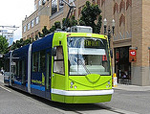Bright hopes, some obstacles for Northern Virginia streetcars
Streetcar supporters in Northern Virginia hope to see streetcar lines traversing many of Northern Virginia’s cities and counties, linking housing to employment centers within and across jurisdictions, often retracing routes operated decades ago.
To get streetcars across boundaries, however, the many local governments must coordinate their plans and deal with differences in their abilities to fund projects.
The Northern Virginia Streetcar Coalition‘s top priority this year is supporting Arlington’s plans for the Columbia Pike and Crystal City streetcar lines. It also will encourage other cities and counties to consider streetcar options.
Arlington has steadfastly supported a vision of smart growth around transit nodes and multimodal transportation options for a great many years. Thanks to this consistency, their work has paid off in positioning Arlington as a good place to live and work.
By selecting streetcar rather than some variety of enhanced bus service, Arlington is reinforcing its past planning efforts by providing investors and developers along the two corridors with the certainty that only a commitment to a fixed alignment can give.
Arlington and Fairfax counties worked together on plans for high-capacity transit along Columbia Pike for several years, and in July 2012 voted to select streetcar as the preferred option for Columbia Pike and apply for federal funding. Arlington also plans a streetcar line for Crystal City to connect with the Columbia Pike line.
The 5 mile long Columbia Pike line, as currently planned, will cross into Fairfax County, terminating at Skyline. The 2½ mile long Crystal City line, on the other hand, will terminate at Four Mile Run, the boundary between Arlington and Alexandria.
Meanwhile, Alexandria has been studying transit for Route 1 and the Beauregard/Van Dorn transit corridors. NVSC wants to ensure no decisions would preclude using streetcars in those areas.
NVSC also will encourage Fairfax County to expand its streetcar lines beyond Skyline, going either toward Falls Church along Route 7, toward Northern Virginia Community College and the Mark Center east of Skyline, or along Route 1 south of Alexandria. Finally, ongoing studies in various jurisdictions could identify additional corridors suitable for streetcars.
Leaders emphasize need for transit, desire to coordinate
In November, the Northern Virginia Streetcar Coalition hosted a public meeting where leaders from Arlington, Fairfax County, Alexandria, and Falls Church discussed, in a spirited but positive manner, regional cooperation in planning high-capacity transit.
They saw Northern Virginia’s future as multimodal, with mixed uses around transit stations. Then-Arlington Board Chair Mary Hynes noted that Virginia commuters to DC must cross Arlington. Without its multi-modal strategy, she said, the county would “become a parking lot.”
All of the officials emphasized that the jurisdictions want work together, and have coordinated in many ways. However, due to differences in funds available for transit and each jurisdiction’s priorities, it has not always been possible to think regionally in spite of best intentions.
Arlington has been more successful at raising funds for transportation capital projects than its neighbors, partially due to its more balanced ratio of commercial to residential property and its commercial add-on tax for transportation.
Paul Smedberg, a member of the Alexandria City Council, spoke of the need for a streetcar connection to the BRAC-133 building at Mark Center. Fairfax Supervisor Penny Gross said that although extensions to the Columbia Pike line are desirable, it was important to get the first segment built rather than bogging down the whole process by considering alternatives.
Former Falls Church City Council member Dan Maller, standing in for Vice-Mayor David Snyder, noted that he was eager to work with Fairfax on a Route 7 extension to Falls Church. Somewhat reassuringly, Alexandrians learned that they would have continuous transit options to get from their city to Arlington without transferring at Four Mile Run — although presently these are bus options rather than streetcar options.
As local and regional plans for high-capacity transit develop, decision-makers must think long-term and regionally. Not every transit route is suitable for streetcars, but where cities and counties want environmentally-sound, reliable, clean transportation that also contributes to local economic development, they should consider streetcar lines and ensure they can interoperate across jurisdictional boundaries now and in the future.


